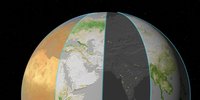Seasonal snow cover is the largest single component of the cryopshere, covering 50% of the northern hemisphere’s land surface during mid-winter, and is an important component of the climate system.
Seasonal snow cover is a crucial and challenging research issue in climate analysis and modelling. It influences energy, moisture and gas fluxes between the land surface and atmosphere; its high reflectivity, or albedo, provides a significant feedback effect in a warming climate; and its sensitivity to precipitation and temperature regimes makes it widely recognised as a fundamental indicator of climate variability and change. Snow is also a major, if not dominant, freshwater source in many alpine, high- and mid-latitude regions an important contribution to the global water cycle.
The Snow_cci project aims to contribute to the understanding of Snow in the climate system by generating consistent, high quality long-term data sets that meet the requirements of the Global Climate Observing System (GCOS).
Objective
The ultimate objective of Snow_cci is to generate homogenized long-time series of daily global snow extent maps from optical satellite data (Figure 1) and daily global snow water equivalent products from passive microwave satellite data (Figure 2).

Figure 1: Prototype of global fractional snow cover (FSC) product from Terra MODIS data from 18-22 March 2017 (generated by ENVEO, 2017).

Figure 2: Demonstration product of snow water equivalent (SWE) on 19 November 2016 over the northern hemisphere from passive microwave data (generated by FMI, 2017).
The goal of the Snow_cci project is to set up reliable, fully validated processing lines for key parameters of the global seasonal snow pack, to be used for re-processing time series of archived satellite data, for processing current satellite observations, and to prepare for exploitation of future satellite data acquisitions.
The Snow_cci will address the primary snow parameters defined by Global Climate Observing System (GCOS), which can be derived from archived and current EO data, namely:
- snow cover area extent (SE)
- snow water equivalent (snow mass; SWE)
The third parameter identified by GCOS, snow depth, cannot be observed directly by archived or current EO data and is not taken into account in this project. However, it can be derived directly from SWE if snow density is known or estimated.
About the project
The technical component in the first phase of the Snow_cci project will focus on development and implementation of methods and processing systems to generate consistent multi-sensor time series of global snow parameters, namely daily fractional snow cover and snow water equivalent, from data of ESA and third-party satellites. These products will contribute to the determination of the long-term trends in seasonal snow since beginning of the early 1980s, currently still a matter of debate due to various inconsistencies between different snow cover data sets, as shown in the ESA QA4EO project Snowpex.
The snow extent product will have a spatial resolution of 1 km and daily global coverage (excluding ice sheets), as illustrated in Figure 1. We will develop and implement a consistent system to generate products of snow on the surface (viewable snow) and snow on the surface corrected for any forest masking (snow on ground). Both products will be expressed as fractional snow per pixel and will be derived from medium resolution optical satellite data. The multisensory time series, starting from the beginning of the 1980s to present day, will include data from AVHRR-2/3, ATSR-2, AATSR, MODIS, Sentinel-3A/B SLSTR and Spot/Proba-V Vegetation. For each product the uncertainty will be estimated for each pixel taking spectral capabilities, calibration and geolocation accuracy into account. A key aspect of the long time series of daily products will be cross-sensor consistency of the products. Aggregation methods will be implemented to generate weekly, bi-weekly, monthly and seasonal snow extent products, following the requests of the science community.
The snow water equivalent production system will be built on the GlobSnow SWE production system (Figure 2) and will be further developed by improving various aspects of the processing chain, including time variable snow density, influence of land cover and implementation of techniques for enhancement of brightness temperature resolution. The daily global time series will be based on SMMR and SSM/I data (from a number of DMSP F-series satellites) starting in 1978 to present day. A key aspect will also be the synergy between the daily time series of snow extent and SWE products, with the aim to get a consistent cross parameter data set.
The snow extent and snow water equivalent products will be made available to the Climate Research Group (CRG) and the wider scientific community, requesting feedback on the quality of the products to further improve the ECV snow products.
Involvement and communication with the international climate research community will be coordinated in two ways, through the User Workshops on user requirements and product specifications and through the following case study projects led by members of the CRG:
Trend analysis of northern hemispheric or global Snow Extent and Snow Water Equivalent, carried out by ECCC
Assessment of output from coordinated model experiments from the ongoing ESM-SnowMIP, LS3MIP and CMIP6 model intercomparison against the Snow_cci products, carried out by CNRS
Extension of the point scale evaluation of historical ESM-SnowMIP simulations with Snow_cci data, carried out by University of Edinburgh
Utilization of Snow_cci products to investigate the role of snow cover changes for the observed changes in the hydrological regime over the large pan-arctic drainage basin of the Arctic Ocean, carried out by SMHI.
Release Note
The 4th snow_cci Climate Research Data Packages (CRDP) including Snow Cover Fraction (SCF) time series from MODIS and AVHRR sensors and Snow Water Equivalent (SWE) time series from SMMR, SSM/I and SSMI/S instruments and the 1st SCF CRDP from SLSTR sensor have been released in Q3/Q4 2025.
Daily SCF products are available with 0.01° (about 1 km) pixel spacing from Terra MODIS data for the period 24/02/2000 – 31/12/2023, and from Sentinel-3 SLSTR data for the period 01/09/2020 – 31/12/2022, and with 0.05° (about 5 km) pixel spacing from AVHRR data for the period 01/01/1979 – 31/12/2023.
In forested areas, the SCF CRDPs provide two different thematic information: snow viewable on top of the forest canopy (SCFV), and snow on the ground (SCFG), i.e., a canopy correction was applied. In non-forested areas, the SCFV and the SCFG products are equal.
Daily SWE products are available with 0.10° (about 10 km) pixel spacing for the winter periods 1979 - 2023. SWE products provide the snow mass information for the Northern Hemispheric land areas, but the geographic extent of the products is global.
Data Access
The snow_cci products are available via the Open Data Portal.
Further details on the dataset and direct access to the dataset are provided at the CEDA archive:
- Global daily Snow Cover Fraction on Ground (SCFG) products from MODIS (2000 - 2023), 1 km pixel spacing
- Global daily Snow Cover Fraction Viewable (SCFV) products from MODIS (2000 - 2023), 1 km pixel spacing
- Global daily Snow Cover Fraction on Ground (SCFG) products from SLSTR (2020 - 2022), 1 km pixel spacing
- Global daily Snow Cover Fraction Viewable (SCFV) products from SLSTR (2020 - 2022), 1 km pixel spacing
- Global daily Snow Cover Fraction on Ground (SCFG) products from AVHRR (1979 - 2023), 5 km pixel spacing
- Global daily Snow Cover Fraction Viewable (SCFV) products from AVHRR (1979 - 2023), 5 km pixel spacing
- Global daily Snow Water Equivalent (SWE) products (1979 - 2023), 10 km pixel spacing
Access the full suite of ESA Climate Change Initiative data products via our dedicate Open Data Portal, including those generated by the CCI Snow project.
Snow Water Equivalent (mm) (version 2.0) - interactive globe
The Snow-cci project satellite-derived data products are available via CEDA (click here to search and download)
The next generation of the snow_cci climate research data packages (CRDPs) was released in Q4 / 2025.
The updated snow_cci CRDPs contains the following time series of satellite based daily global snow products:
- Snow Cover Fraction Viewable (SCFV) - in forests, snow viewable on top of forest canopy is mapped from
- Terra MODIS data (2000 - 2023), CRDP v4.0
- AVHRR data (1979 - 2023), CRDP v4.0
- SLSTR data (2020 - 2022), CRDP v1.0 - will be gradually extended within the Copernicus Climate Change Service (C3S) for Cryosphere
- Snow Cover Fraction on Ground (SCFG) - canopy correction applied to map snow on ground also in forested areas from
- Terra MODIS data (2000 - 2023), CRDP v4.0
- AVHRR data (1979 - 2023), CRDP v4.0
- SLSTR data (2020 - 2022), CRDP v1.0 - will be gradually extended within the Copernicus Climate Change Service (C3S) for Cryosphere
- Snow Water Equivalent (1979 - 2023), CRDP v4.0
This page is updated on a regular basis when new documents / versions become available.
The Snow_cci team consists of 11 scientific and industrial partners from nine different countries.
The team is organised as follows:
- Science lead – Dr. Thomas Nagler, ENVEO (Environmental Earth Observation IT GmbH), Austria.
- Project Management - Dr. Gabriele Schwaizer, ENVEO (Environmental Earth Observation IT GmbH), Austria.
- Earth Observation Science Team – led by Dr. Stefan Wunderle, University of Berne, Switzerland.
- Snow Cover Extent development and production team: Dr. Gabriele Schwaizer (ENVEO), Dr. Thomas Nagler (ENVEO), Dr. Rune Solberg (NR), Dr. Stefan Wunderle (University of Berne), Dr. Sari Metsämäki (SYKE)
- Snow Water Equivalent development and production team: Dr. Kari Luojus (FMI), Dr. Jouni Pulliainen (FMI), Dr. Chris Derksen (ECCC), Dr. Lawrence Mudryk (ECCC)
- Validation Team – led by Dr. Carlo Marin, EURAC, Italy.
- System Engineering Team – led by Dr. Andreas Wiesmann, GAMMA Remote Sensing, Switzerland.
- Climate Research Group – led by Dr. Chris Derksen, Environment and Climate Change Canada (ECCC), Canada.
ENVEO (Environmental Earth Observation IT GmbH), Austria, is the project leader, responsible for the scientific coordination and the technical project management of the project, relations with ESA and communications with relevant scientific communities. ENVEO is also leading the algorithm development activities and is contributing to the generation of snow extent products.
Environment and Climate Change Canada (ECCC), Canada, is leading the Climate Research Group. Further, ECCC is together with FMI responsible for the algorithm development and generation of snow water equivalent products.
EURAC Research, Italy, has the lead of the Validation Team and is responsible for independent validation activities of all snow products generated in the Snow_cci project.
Finnish Meteorological Institute (FMI), Finland, is together with ECCC responsible for the algorithm development and is leading the generation of snow water equivalent products.
GAMMA Remote Sensing AG (GAMMA), Switzerland, is responsible for all system engineering activities in the project and is contributing to the generation of snow extent products.
Norwegian Computing Centre (NR), Norway, is responsible for the end-2-end uncertainty characterisation of the snow products as well as for the generation of the ECV snow products. Further, NR is contributing to the algorithm development for snow extent products.
University of Berne (UBE), Switzerland, has the lead of the EO Science Team and is responsible for the requirements management. Further, UBE is contributing to algorithm development and the generation of snow extent products and to the validation of snow water equivalent products.
Finnish Environment Institute (SYKE), Finland, is contributing to the algorithm development for snow extent product.
The Climate Research Group, under the lead of Dr. Chris Derksen (ECCC) are external experts who assess the user requirements and define the specifications for snow products generated within the Snow_cci project. The following members of the Climate Research Group are each performing a use case study to assess the impact of the ECV snow products for climate monitoring and research:
- Dr. Gerhard Krinner, Centre National de la Recherche Scientifique (CNRS / IGE), France
- Dr. David Gustafsson, Swedish Meteorological and Hydrological Institute (SMHI), Sweden
- Dr. Richard Essery, School of Geosciences, University of Edinburgh, United Kingdom
Dr. Patricia de Rosnay from the European Centre for Medium-Range Weather Forecasts (ECMWF) supports the CRG as external expert.
- Derksen, C. and L. Mudryk. Assessment of Arctic seasonal snow cover rates of change. The Cryosphere. 2023, 17, p. 1431–1443. https://doi.org/10.5194/tc-17-1431-2023
- Elias Chereque, A., Kushner, P. J., Mudryk, L., Derksen, C., and Mortimer, C.. A simple snow temperature index model exposes discrepancies between reanalysis snow water equivalent products. The Cryosphere. 2024, 18, 4955–4969. https://doi.org/10.5194/tc-18-4955-2024
- Keuris, L., M. Hetzenecker, T. Nagler, N. Mölg, and G. Schwaizer. An Adaptive Method for the Estimation of Snow-Covered Fraction with Error Propagation for Applications from Local to Global Scales. Remote Sensing. 2023, 15(5), p. 1231. https://doi.org/10.3390/rs15051231
- Kouki, K., P. Räisänen, K. Luojus, A. Luomaranta, and A. Riihelä. Evaluation of Northern Hemisphere snow water equivalent in CMIP6 models with satellite-based SnowCCI data during 1982–2014. The Cryosphere. 2022, 16, p. 1007–1030. https://doi.org/10.5194/tc-16-1007-2022
- Krinner, G., C. Derksen, R. Essery, M. Flanner, S. Hagemann, M. Clark, A. Hall, H. Rott, C. Brutel-Vuilmet, H. Kim, C.B. Ménard, L. Mudryk, C. Thackeray, L. Wang, G. Arduini, G. Balsamo, P. Bartlett, J. Boike, A. Boone, F. Chéruy, J. Colin, et al.. ESM-SnowMIP: assessing snow models and quantifying snow-related climate feedbacks. Geoscientific Model Development. 2018, 11, p. 5027-5049. https://doi.org/10.5194/gmd-11-5027-2018
- Lalande, M., Ménégoz, M., Krinner, G., Ottlé, C., and Cheruy, F.. Improving climate model skill over High Mountain Asia by adapting snow cover parameterization to complex-topography areas. The Cryosphere. 2023, 17, 5095–5130. https://doi.org/10.5194/tc-17-5095-2023
- Lalande, M., M. Ménégoz, G. Krinner, K. Naegeli, and S. Wunderle. Climate change in the High Mountain Asia in CMIP6. Earth System Dynamics. 2021, 12, p. 1061–1098. https://doi.org/10.5194/esd-12-1061-2021
- Lebedeva, L.; Gustafsson, D.. Streamflow Changes of Small and Large Rivers in the Aldan River Basin, Eastern Siberia. Water. 2021, 13, 2747. https://doi.org/10.3390/w13192747
- Luojus, K., J. Pulliainen, M. Takala, J. Lemmetyinen, C. Mortimer, C. Derksen, L. Mudryk, M. Moisander, M. Hiltunen, T. Smolander, J. Ikonen, J. Cohen, M. Salminen, J. Norberg, K. Veijola, and P. Venäläinen. GlobSnow v3.0 Northern Hemisphere snow water equivalent dataset. Scientific Data. 2021, 8, p. 163. https://doi.org/10.1038/s41597-021-00939-2
- Mortimer, C., Mudryk, L., Cho, E., Derksen, C., Brady, M., and Vuyovich, C.. Use of multiple reference data sources to cross validate gridded snow water equivalent products over North America. The Cryosphere. 2024, 18, 5619–5639. https://doi.org/10.5194/tc-18-5619-2024
- Mortimer, C., L. Mudryk, C. Derksen, M. Brady, K. Luojus, P. Venäläinen, M. Moisander, J. Lemmetyinen, M. Takala, C. Tanis , J. Pulliainen. Benchmarking algorithm changes to the Snow CCI+ snow water equivalent product. Remote Sensing of Environment. 2022, 274. https://doi.org/10.1016/j.rse.2022.112988
- Mortimer, C., L. Mudryk, C. Derksen, K. Luojus, R. Brown, R. Kelly, and M. Tedesco. Evaluation of long-term Northern Hemisphere snow water equivalent products. The Cryosphere. 2020, 14, p. 1579-1594. https://doi.org/10.5194/tc-14-1579-2020
- Mudryk, L., Mortimer, C., Derksen, C., Elias Chereque, A., and Kushner, P.. Benchmarking of snow water equivalent (SWE) products based on outcomes of the SnowPEx+ Intercomparison Project. The Cryosphere. 2025, 19, 201–218. https://doi.org/10.5194/tc-19-201-2025
- Mudryk, L., Elias Chereque, A., Derksen, C., Luojus, K. and Decharme, B.. Terrestrial Snow Cover [in “State of the Climate in 2022”].. Bulletin of the American Meteorological Society. 2023, 104 (9), S295–S298. https://doi.org/10.1175/BAMS-D-23-0079.1
- Mudryk, L., Elias Chereque, A., Derksen, C., Luojus, K. and Decharme, B.. Terrestrial Snow Cover [in “State of the Climate in 2021”].. Bulletin of the American Meteorological Society. 2022, 103 (8), S283–S286. https://doi.org/10.1175/BAMS-D-22-0082.1
- Mudryk, L. R., A. Elias Chereque, C. Derksen, K. Luojus, and B. Decharme. Terrestrial Snow Cover. Arctic Report Card 2021. 2021, R. L. Thoman, J. Richter-Menge, and M. L. Druckenmiller, Eds.. https://doi.org/10.25923/16xy-9h55
- Mudryk, L., Santolaria-Otín, M., Krinner, G., Ménégoz, M., Derksen, C., Brutel-Vuilmet, C., Brady, M., and Essery, R.. Historical Northern Hemisphere snow cover trends and projected changes in the CMIP6 multi-model ensemble. The Cryosphere. 2020, 14, 2495–2514. https://doi.org/10.5194/tc-14-2495-2020
- Musuuza, J.L., Gustafsson, D., Pimentel, R., Crochemore, L., Pechlivanidis, P.. Impact of satellite and in situ data assimilation on hydrological predictions. Remote Sensing. 2020, 12(5), 811. https://doi.org/10.3390/rs12050811
- Naegeli, K., J. Franke, C. Neuhaus, N. Rietze, M. Stengel, X. Wu, and S. Wunderle. Revealing four decades of snow cover dynamics in the Hindu Kush Himalaya. Scientific reports. 2022, 12(1), p. 13443. https://doi.org/10.1038/s41598-022-17575-4
- Priestley, A.. Using geophysical data to understand liquid water dynamics in seasonal snow. University of Edinburgh. 2022, PhD thesis. http://dx.doi.org/10.7488/era/2771
- Pulliainen, J., K. Luojus, C. Derksen, L. Mudryk, J. Lemmetyinen, M. Salminen, J. Ikonen, M. Takala, J. Cohen, T. Smolander, and J. Norberg. Patterns and trends of Northern Hemisphere snow mass from 1980 to 2018. Nature. 2020, 581, p. 294-298. https://doi.org/10.1038/s41586-020-2258-0
- Sun, H., Fang, Y., Margulis, S. A., Mortimer, C., Mudryk, L., and Derksen, C.. Evaluation of the Snow Climate Change Initiative (Snow CCI) snow-covered area product within a mountain snow water equivalent reanalysis. The Cryosphere. 2025, 19, 2017–2036. https://doi.org/10.5194/tc-19-2017-2025
- Venäläinen, P., C. Mortimer, K. Luojus, L. Mudryk, M. Takala, and J. Pulliainen. Updated monthly and new daily bias correction for assimilation-based passive microwave SWE retrieval. The Cryosphere. 2025, 19, 6301-6318. https://doi.org/10.5194/tc-19-6301-2025
- Venäläinen, P., K. Luojus, C. Mortimer, J. Lemmetyinen, J. Pulliainen, M. Takala, M. Moisander, and L. Zschenderlein. Implementing spatially and temporally varying snow densities into the GlobSnow snow water equivalent retrieval. The Cryosphere. 2023, 17(2), p. 719-736. https://doi.org/10.5194/tc-17-719-2023
- Venäläinen, P., K. Luojus, J. Lemmetyinen, J. Pulliainen, M. Moisander, and M. Takala. Impact of dynamic snow density on GlobSnow snow water equivalent retrieval accuracy. The Cryosphere. 2021, 15, p. 2969–2981. https://doi.org/10.5194/tc-15-2969-2021
- Wu, X., K. Naegeli, V. Premier, C. Marin, D. Ma, J. Wang, J. and S. Wunderle. Evaluation of snow extent time series derived from Advanced Very High Resolution Radiometer global area coverage data (1982–2018) in the Hindu Kush Himalayas. The Cryosphere. 2021, 15(9), p. 4261-4279. https://doi.org/10.5194/tc-15-4261-2021
- Zschenderlein L., K. Luojus, M. Takala, P. Venäläinen, and J. Pulliainen. Evaluation of passive microwave dry snow detection algorithms and application to SWE retrieval during seasonal snow accumulation. Remote Sensing of Environment. 2023, 288, p. 113476. https://doi.org/10.1016/j.rse.2023.113476
Key contacts for the Snow project:
- Scientific Leader – Thomas Nagler: thomas.nagler@enveo.at
- Project Manager – Gabriele Schwaizer: gabriele.schwaizer@enveo.at
- ESA Technical Officer – Sophie Hebden: sophie.hebden@esa.int
- ESA Technical Officer (on leave) – Anna Maria Trofaier: anna.maria.trofaier@esa.int
- General and technical support – Gabriele Schwaizer: gabriele.schwaizer@enveo.at
To run this example yourself, go to https://dashboard.climate.hub-otc.eox.at/. You can register for free.
Latest news & events

CCI colocation & CMUG integration meeting 2026
Annual gathering of the CCI community for ESA programme updates, scientific progress, and forward-looking discussions.
Meer leren
New Position: Junior Professional in AI for Climate Science
Opportunity for early-career Artificial Intelligence talent to join ESA’s Actionable Climate Information Section
Meer leren
Working for ESA: procurement and proposal submission process
An Introduction to ESA Star - ESA's System for Tendering and Registration
Meer leren
ESA at COP29
ESA is participating in COP29 to highlighting satellites' role in tackling climate change
Meer leren

Land Surface Temperature 2024 User Workshop Save the date: 5th and 6th December 2024
Call for abstracts and registration
Meer leren
Call for new projects: Additional Essential Climate Variables
New R&D procurement as part of ESA's CLIMATE-SPACE programme
Meer leren
Open Competitive Tender for CLIMATE-SPACE Knowledge Exchange
ESA Tender Action Number: 1-12141. ESA Activity Number: 1000039650.
Meer leren
Little Pictures winner announced at COP28
Results of Europe-wide climate data visualisation showcased
Meer leren
New Tender: CROSS-ECV ACTIVITIES Tender Action Number: 1-12062
New tender issued by the ESA Climate Office (Activity Number: 1000039196)
Meer leren
Harnessing Earth Observation for Climate Action
ESA in conversation Prof Jim Skea with IPCC Chair during the COP28 Earth Information day
Meer leren
COP28: ESA Climate Office events
The Climate Office is contributing to several events at COP28, UAE, Dubai
Meer leren










